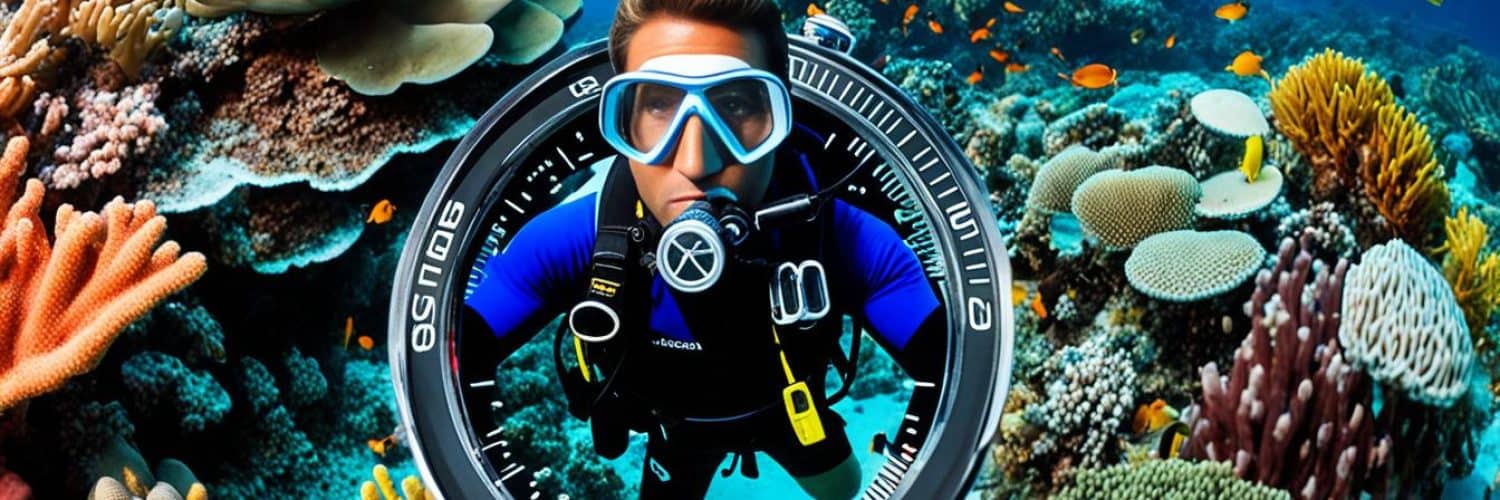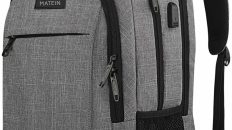A dive compass is an essential piece of gear for any scuba diver. It provides accurate bearing readings, allowing divers to navigate underwater with ease and confidence. Whether you’re exploring a vibrant coral reef or diving in a mysterious shipwreck, a reliable dive compass is a must-have tool to ensure you never get lost in the depths.
In this article, we will discuss the best travel dive compasses available on the market. We will focus on their reliability, quality, and functionality, helping you make an informed decision when choosing the perfect compass for your underwater adventures. From top-rated brands to high-quality options, we’ve got you covered.
Key Takeaways:
- A dive compass is an essential tool for scuba divers, providing accurate bearing readings for underwater navigation.
- Choosing a high-quality and reliable dive compass is crucial for ensuring safe and enjoyable dives.
- Consider features such as easy-to-read displays, tilt tolerance, night reading capabilities, and compass size when selecting a dive compass.
- Mounting options for dive compasses include wrist mount, console mount, retractor mount, and slate mount.
- It is necessary to use a dive compass balanced for the specific hemisphere you are diving in.
Why You Need a Dive Compass
A dive compass is crucial for all divers, serving as an essential navigational tool underwater. It plays a vital role in preventing divers from getting lost, especially in complex or unfamiliar dive sites. Even experienced divers can benefit from using a dive compass, particularly in challenging conditions such as strong currents or poor visibility. Navigating with a dive compass is a fundamental safety practice that every diver should prioritize.
Dive compasses provide accurate bearing readings, allowing divers to maintain their course and avoid getting disoriented in the underwater environment. By providing a reliable sense of direction, dive compasses play a significant role in preventing potentially dangerous situations underwater.
Using landmarks and natural navigation aids may not always be feasible, especially in deep or dark conditions. A dive compass ensures that divers can navigate confidently and effectively, regardless of visibility limitations.
Prevent Getting Lost:
A dive compass serves as a vital navigational tool that prevents divers from getting lost underwater. It provides accurate bearing readings, helping divers maintain their course and navigate safely.
Importance of a Dive Compass:
- Prevent getting lost in complex or unfamiliar dive sites
- Ensure safety in challenging diving conditions such as strong currents or poor visibility
- Maintain navigational accuracy without relying on landmarks or natural navigation aids
Essential Navigational Tool for Divers:
A dive compass is an essential tool that every diver should have in their dive kit. It is a reliable and accurate navigational device that ensures divers can confidently explore the underwater world.
Learn more about the features to consider in a dive compass in the next section.
Features to Consider in a Dive Compass
When choosing a dive compass, it is important to consider certain features. These features will enhance your diving experience and ensure accurate navigation underwater. Here are the key features to look for:
Easy-to-Read Compass
An easy-to-read compass is essential for quick and accurate readings underwater. Look for a compass with clear markings and large numerals that are visible even in challenging conditions.
Tilt Tolerance
Consider the tilt tolerance of the compass. A higher tilt potential allows for accurate readings even when the compass is not held completely flat. This feature is particularly useful when dealing with strong currents or awkward diving positions.
Night Reading
For dives in low light or dark conditions, choose a compass with night reading capabilities. Look for phosphorescent markings that glow in the dark, ensuring easy navigation even when visibility is limited.
Lubber Line and Side View Window
The presence of a lubber line and a side view window in a dive compass aids in navigation. The lubber line helps align the compass with the desired direction, while the side view window allows for quick and easy readings while maintaining the compass in a proper position.
Compass Size
Consider the size of the compass based on your visibility preferences and personal comfort. A larger compass may offer better visibility, but it might be heavier and bulkier to carry. Choose a size that suits your diving needs.
By considering these features, you can select a dive compass that meets your specific requirements for accurate and easy navigation underwater.
Dive Compass Mounting Options
Dive compasses offer various mounting options to cater to different preferences and diving styles. Choosing the right compass mounting option is essential for easy accessibility and convenience during dives. Here are the most common mounting options:
1. Wrist Mount
A wrist-mounted compass is a popular choice among divers. It is worn on the wrist like a watch, providing easy visibility and quick access to navigation information. The wrist mount option allows for hands-free navigation, making it convenient for divers to check their bearings while swimming.
2. Console Mount
Console mount compasses are integrated into dive instrument consoles. They usually feature a combination of dive gauges and instruments, including a compass. While console mount compasses provide an all-in-one solution, they can be slightly awkward to read compared to wrist-mounted compasses.
3. Retractor Mount
A retractor-mounted compass is clipped to a D-ring on the BCD (buoyancy control device). It can be easily pulled out and deployed when needed and retracts back to a secure position when not in use. Retractor-mount compasses offer flexibility and are suitable for divers who prefer to keep their compass easily accessible while minimizing the risk of entanglement.
4. Slate Mount
Slate mount compasses are primarily used for precise survey work rather than regular dive navigation. They are mounted on a dive slate, which allows divers to record accurate compass readings and other important information during underwater surveys and explorations. Slate mount compasses are not commonly used for general dive navigation purposes.
When choosing a dive compass mounting option, consider your personal preference, comfort, and ease of use. It is important to ensure that the mounting option you choose does not interfere with your diving equipment or impede your ability to read the compass accurately.
Choose the mounting option that best suits your needs and enhances your overall diving experience. Now, let’s explore the different balance zones for dive compasses in the next section.
Dive Compass Balance Zones
Compasses play a vital role in underwater navigation, allowing divers to find their way and explore safely. However, it’s important to understand that compasses are designed to align with specific geographic zones due to the Earth’s magnetic field variations. This ensures accurate readings and reliable navigation underwater.
Compasses are balanced for either the Southern Hemisphere or the Northern Hemisphere, with some overlap between the two. Using a compass that is balanced for the correct zone is crucial for accurate navigation. Using the wrong compass in a specific zone can lead to incorrect readings and potentially getting lost underwater.
When purchasing a dive compass online, it is essential to check that it is balanced for your specific geographic location. The product description or specifications should indicate whether the compass is suitable for the Southern Hemisphere or the Northern Hemisphere.
To provide an example, let’s consider the Southern Hemisphere and the Northern Hemisphere compasses:
Southern Hemisphere Compass
Designed specifically for use in the Southern Hemisphere, this compass is balanced to align with the Earth’s magnetic field in that region. It provides accurate readings for divers exploring dive sites in countries such as Australia, New Zealand, South Africa, and Brazil.
Northern Hemisphere Compass
Designed for use in the Northern Hemisphere, this compass is balanced to align with the Earth’s magnetic field in that region. It provides accurate readings for divers exploring dive sites in countries such as the United States, Canada, the United Kingdom, and Japan.
Using a dive compass balanced for the correct hemisphere zone ensures that divers can rely on accurate readings and navigate their underwater adventures with confidence.
By understanding the importance of dive compass balance zones and using the correct compass for specific geographic regions, divers can enhance their safety and have a more enjoyable diving experience.
Best Diving Compasses
When it comes to choosing the best diving compass, the Suunto SK-8 stands out as a top recommendation. Suunto, a reputable brand in the diving industry, offers a range of reliable and accurate dive compasses that are trusted by divers worldwide.
The Suunto SK-8 is available in two options: the wrist strap dive compass and the bungee mount dive compass. The wrist strap option provides convenience and ease of use, while the bungee mount option offers flexibility and quick deployment during dives.
Aside from Suunto, there are other top diving compass brands to consider. Brands like Oceanic, Cressi, Sherwood, and XS Scuba also offer a variety of compass options with different features and price points. These brands have established themselves as leaders in the industry, consistently delivering high-quality dive compasses that meet the needs of divers at all levels of experience.
Key Features Comparison
| Brand | Compass Type | Price Range | Key Features |
|---|---|---|---|
| Suunto | Wrist Strap Bungee Mount |
$100 – $200 $100 – $200 |
Reliable and accurate Easy-to-use Durable construction High tilt tolerance |
| Oceanic | Wrist Strap Console Mount |
$80 – $150 $150 – $300 |
Clear and easy-to-read display Phosphorescent markings Tilt compensation Integrated compass module |
| Cressi | Wrist Strap | $60 – $100 | Oil-filled capsule Side view window Tilting bezel |
| Sherwood | Wrist Strap | $100 – $200 | Lubber line Side view window High tilt tolerance Nighttime visibility |
| XS Scuba | Wrist Strap | $70 – $120 | Oil-filled capsule Quick response and accurate readings Large numerals |
Each brand offers unique features and benefits, so it’s important to consider your personal preferences and diving requirements when choosing a dive compass. Whether you prioritize accuracy, durability, or specific functionality, there is a dive compass option for every diver.
Top Picks for Travel Dive Compasses
When it comes to travel dive compasses, two top picks stand out: the Suunto SK-8 Wrist Strap Dive Compass and the Suunto SK-8 Bungee Mount Dive Compass. These compasses are highly recommended for their exceptional performance and accuracy, making them reliable companions for divers seeking precise navigation underwater.
The Suunto SK-8 Wrist Strap Dive Compass is a versatile choice, designed for divers who prefer a compact and wearable compass. Its easy-to-read display and high tilt tolerance ensure accurate readings, even in challenging conditions. The wrist strap design allows for comfortable and convenient use throughout the dive.
The Suunto SK-8 Bungee Mount Dive Compass offers quick deployment and easy access during dives. Designed to be attached to a bungee mount system, this compass allows divers to have their navigation tool readily available whenever they need it. With clear markings and excellent tilt tolerance, this compass ensures accurate readings for a safe and successful dive.
Comparison of Suunto SK-8 Wrist Strap and Bungee Mount Dive Compasses
| Suunto SK-8 Wrist Strap Dive Compass | Suunto SK-8 Bungee Mount Dive Compass | |
|---|---|---|
| Design | Wrist strap | Bungee mount |
| Readability | Easy-to-read display | Clear markings |
| Tilt Tolerance | High tilt tolerance | Excellent tilt tolerance |
| Convenience | Versatile and wearable | Quick deployment |
| Usability | Comfortable and convenient | Easy access during dives |
Both compasses are built with durability and reliability in mind, making them ideal choices for travel and adventure diving. Whether you prefer the versatility of a wrist strap or the convenience of a bungee mount, these compasses are sure to meet your navigational needs.
Other Considerations and Care for Dive Compasses
To ensure the longevity of your dive compass, it is important to take proper care of it. Here are some essential considerations and maintenance tips:
1. Rinsing After Use
After each dive, make sure to rinse your dive compass with fresh water to remove salt and debris. Salt can corrode the compass housing and affect its accuracy. Use a gentle stream of water and ensure that all parts of the compass are thoroughly rinsed.
2. Repairing Bubbles
Over time, bubbles may form inside the compass, which can impact its accuracy. If you notice bubbles in your dive compass, it is important to get them repaired. Contact the manufacturer or a trusted dive shop that offers compass repair services. They can remove the bubbles and restore the compass to its optimal working condition.
3. Fixing a Stuck Compass
If you encounter a stuck compass where the needle fails to move freely, there are a few methods you can try to fix it. Firstly, give the compass a few gentle taps to dislodge any debris or loosen the components. Alternatively, you can try exposing the compass to warm water to expand the internal components and free up the needle. Be cautious not to use excessive force or apply hot water that may damage the compass.
4. Regular Maintenance and Manufacturer’s Instructions
Regular maintenance is vital to keep your dive compass in optimal condition. Follow the manufacturer’s instructions for cleaning and storing the compass. Avoid exposing the compass to extreme temperatures or direct sunlight, as this can affect its functionality. If the compass requires any lubrication or adjustments, refer to the manufacturer’s guidelines or consult a professional dive technician.
Note: Proper care and maintenance are essential to ensure the accuracy and longevity of your dive compass. By following these guidelines, you can enjoy reliable navigation and precise readings on your underwater adventures.
Conclusion
In conclusion, a dive compass is an essential and reliable navigation tool for divers. When it comes to the best travel dive compasses, the Suunto SK-8 Wrist Strap Dive Compass and the Suunto SK-8 Bungee Mount Dive Compass are top picks. These compasses offer exceptional accuracy, durability, and ease of use, making them the ideal choice for divers in need of a reliable orientation tool.
Proper care and maintenance are crucial to ensure the longevity of a dive compass. It is important to rinse the compass after each use to remove salt and debris. Repairing bubbles and fixing a stuck compass can be done with some handy tricks. By following these practices and the manufacturer’s instructions, divers can keep their dive compass in optimal condition, ensuring it remains a trusted companion in all their underwater adventures.
In summary, a dive compass is an essential piece of gear for divers, providing reliable navigation underwater. The Suunto SK-8 Wrist Strap Dive Compass and the Suunto SK-8 Bungee Mount Dive Compass are among the best options for travel dive compasses. With their accuracy, durability, and ease of use, these compasses serve as reliable navigation tools, making them essential for divers of all levels. Taking proper care of a dive compass will ensure it remains a trusted and indispensable tool for underwater exploration.
FAQ
Why do I need a dive compass?
A dive compass is an essential navigational tool for divers, helping to prevent getting lost underwater and ensuring a safe dive.
What features should I consider in a dive compass?
When choosing a dive compass, look for features such as easy-to-read markings, large numerals, high tilt tolerance, night reading capabilities, a lubber line, side view window, and the appropriate compass size.
What are the mounting options for a dive compass?
Dive compasses can be wrist-mounted, console-mounted, retractor-mounted, or slate-mounted, depending on personal preference and diving style.
Are dive compasses balanced for specific zones?
Yes, dive compasses are balanced for either the Southern hemisphere or the Northern hemisphere. It’s important to use a compass balanced for the zone in which you are diving to ensure accurate readings.
What are the best diving compasses?
The top diving compass brands include Suunto, Oceanic, Cressi, Sherwood, and XS Scuba, with Suunto SK-8 being highly recommended for its reliability and accuracy.
What are the top picks for travel dive compasses?
The top picks for travel dive compasses are the Suunto SK-8 Wrist Strap Dive Compass and the Suunto SK-8 Bungee Mount Dive Compass, both offering excellent performance, accuracy, and durability.
How should I care for my dive compass?
To ensure the longevity of a dive compass, it is important to rinse it after each use to remove salt and debris. Bubbles can be repaired, and a stuck compass can be fixed by tapping or exposing it to hot water.







Add comment